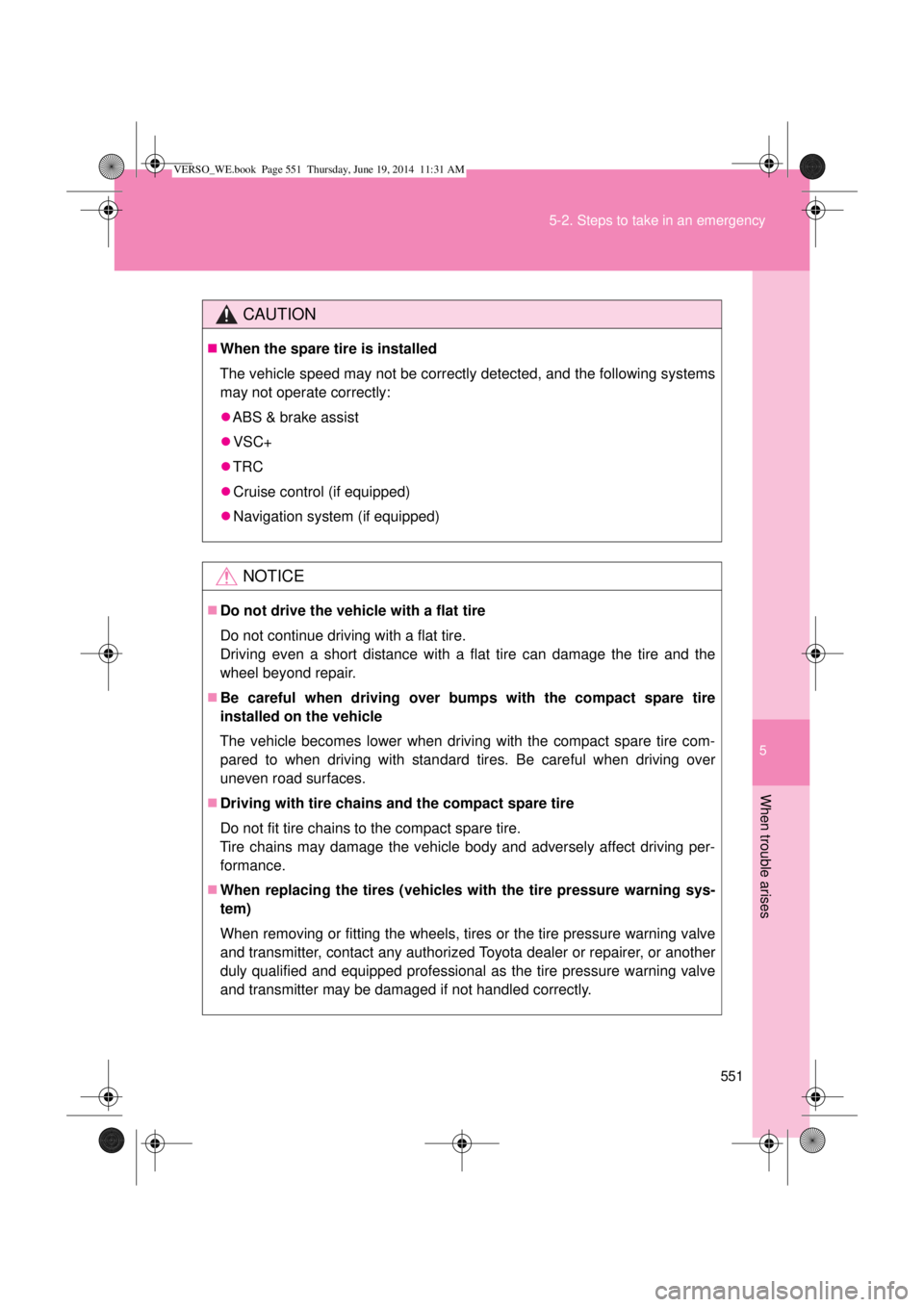Page 550 of 650

550 5-2. Steps to take in an emergency
CAUTION
Replacing a flat tire
Failure to follow these precautions could cause the wheel nuts to loosen
and the tire to fall off, resulting in death or serious injury.
• Have the wheel nuts tightened with a torque wrench to 103 N·m (10.5
kgf·m, 76 ft·lbf) as soon as possible after changing wheels.
• When installing a tire, only use wheel nuts that have been specifically
designed for that wheel.
• If there are any cracks or deformations in the bolt screws, nut threads
or bolt holes of the wheel, have the vehicle inspected by any autho-
rized Toyota dealer or repairer, or another duly qualified and equipped
professional.
• When installing the wheel nuts, be sure to install them with the tapered
ends facing inward. (P. 460)
• Do not attach a heavily damaged wheel ornament, as it may fly off the
wheel while the vehicle is moving.
When using the full-size spare tire (vehicles with the tire pressure
warning system or a spare tire of different wheel type from the installed
tires)
Replace the full-size spare tire with a standard tire as soon as possible.
Avoid sudden acceleration, deceleration and braking, as well as sharp cor-
nering.
When using the compact spare tire
Remember that your compact spare tire is specifically designed for use
with your vehicle. Do not use your compact spare tire on another vehicle.
Do not use more than one compact spare tire simultaneously.
Replace the compact spare tire with a standard tire as soon as possible.
Avoid sudden acceleration, abrupt steering, sudden braking and shifting
operations that cause sudden engine braking.
Speed limit when using the compact spare tire
Do not drive at speeds in excess of 80 km/h (50 mph) when a compact spare
tire is installed on the vehicle.
The compact spare tire is not designed for driving at high speeds. Failing to
observe this precaution may lead to an accident causing death or serious
injury.
VERSO_WE.book Page 550 Thursday, June 19, 2014 11:31 AM
Page 551 of 650

5
551 5-2. Steps to take in an emergency
When trouble arises
CAUTION
When the spare tire is installed
The vehicle speed may not be correctly detected, and the following systems
may not operate correctly:
ABS & brake assist
VSC+
TRC
Cruise control (if equipped)
Navigation system (if equipped)
NOTICE
Do not drive the vehicle with a flat tire
Do not continue driving with a flat tire.
Driving even a short distance with a flat tire can damage the tire and the
wheel beyond repair.
Be careful when driving over bumps with the compact spare tire
installed on the vehicle
The vehicle becomes lower when driving with the compact spare tire com-
pared to when driving with standard tires. Be careful when driving over
uneven road surfaces.
Driving with tire chains and the compact spare tire
Do not fit tire chains to the compact spare tire.
Tire chains may damage the vehicle body and adversely affect driving per-
formance.
When replacing the tires (vehicles with the tire pressure warning sys-
tem)
When removing or fitting the wheels, tires or the tire pressure warning valve
and transmitter, contact any authorized Toyota dealer or repairer, or another
duly qualified and equipped professional as the tire pressure warning valve
and transmitter may be damaged if not handled correctly.
VERSO_WE.book Page 551 Thursday, June 19, 2014 11:31 AM
Page 556 of 650
556 5-2. Steps to take in an emergency
Before performing emergency repair
Check the degree of the tire
damage.
• Do not remove the nail or
screw from the tire. Removing
the object may widen the
opening and prevent emer-
gency repair with the repair kit.
• Type A: To avoid sealant leak-
age, move the vehicle until the
area of the puncture, if known,
is positioned at the top of the
tire.
Type B
Power plug
Compressor switch
Air pressure gauge
HoseNozzle
Stickers
Pressure release
button
VERSO_WE.book Page 556 Thursday, June 19, 2014 11:31 AM
Page 557 of 650
5
557 5-2. Steps to take in an emergency
When trouble arises
Taking out the emergency tire puncture repair kit
Open the rear deck board. (P. 393)
Take out the emergency tire puncture repair kit. (P. 553)
In the following cases, the tire cannot be repaired with the emergency
tire puncture repair kit. Contact any authorized Toyota dealer or
repairer, or another duly qualified and equipped professional.
When the tire is damaged due to driving without sufficient air pressure
When there are any cracks or damage at any location on the tire, such as
on the side wall, except the tread
When the tire is visibly separated from the wheel
When the cut or damage to the tread is 4 mm (0.16 in.) long or more
When the wheel is damaged
When two or more tires have been punctured
When more than 2 sharp objects such as nails or screws have passed
through the tread on a single tire
When the sealant has expired
VERSO_WE.book Page 557 Thursday, June 19, 2014 11:31 AM
Page 561 of 650
5
561 5-2. Steps to take in an emergency
When trouble arises
Check the specified inflation pressure.
The label is placed as shown in the illustration.
Left-hand drive vehicles
Right-hand drive vehicles
Turn the compressor switch on
and fill the tire with air until the
specified inflation pressure is
reached.
Switch
VERSO_WE.book Page 561 Thursday, June 19, 2014 11:31 AM
Page 562 of 650
562 5-2. Steps to take in an emergency
Turn the switch off when the pressure gauge connected to the
hose reads the specified pressure.
If the inflation pressure is not attained within 5 minutes, emergency
repair is not possible due to severe damage. Contact any authorized
Toyota dealer or repairer, or another duly qualified and equipped pro-
fessional.
After completely filling the tire with air, disconnect the hose
from the valve on the tire.
Pull the power plug of the compressor out of the power outlet
on the vehicle.
To spread the liquid sealant evenly in the tire, immediately
drive for about 5 km (3 miles) or 10 minutes.
After driving about 5 km (3 miles)
or 10 minutes, pull your vehicle
over in a safe place and recon-
nect the compressor.
Read the inflation pressure on
the pressure gauge.
VERSO_WE.book Page 562 Thursday, June 19, 2014 11:31 AM
Page 563 of 650
5
563 5-2. Steps to take in an emergency
When trouble arises
If the pressure is 130 kPa (1.3
kgf/cm2 or bar, 18 psi) or above,
fill the tire with air using the com-
pressor until the specified infla-
tion pressure is reached.
If the pressure is less than 130
kPa (1.3 kgf/cm
2 or bar, 18 psi),
the emergency repair that has
been performed is not safe for
use as damage to the tire is too
severe. Do not continue to drive
the vehicle. Contact any autho-
rized Toyota dealer or repairer, or
another duly qualified and
equipped professional.
Attach the 2 stickers as shown.
Remove any dirt and moisture
from the wheel before attaching
the label. If it is impossible to
attach the label, make sure to tell
any authorized Toyota dealer or
repairer, or other duly qualified
and equipped professional when
you have them repair and replace
the tire that sealant is injected.
VERSO_WE.book Page 563 Thursday, June 19, 2014 11:31 AM
Page 567 of 650
5
567 5-2. Steps to take in an emergency
When trouble arises
Check the specified inflation pressure.
The label is placed as shown in the illustration.
Left-hand drive vehicles
Right-hand drive vehicles
Start the vehicle’s engine.
To inject the sealant and inflate
the tire, turn the compressor
switch on.
VERSO_WE.book Page 567 Thursday, June 19, 2014 11:31 AM